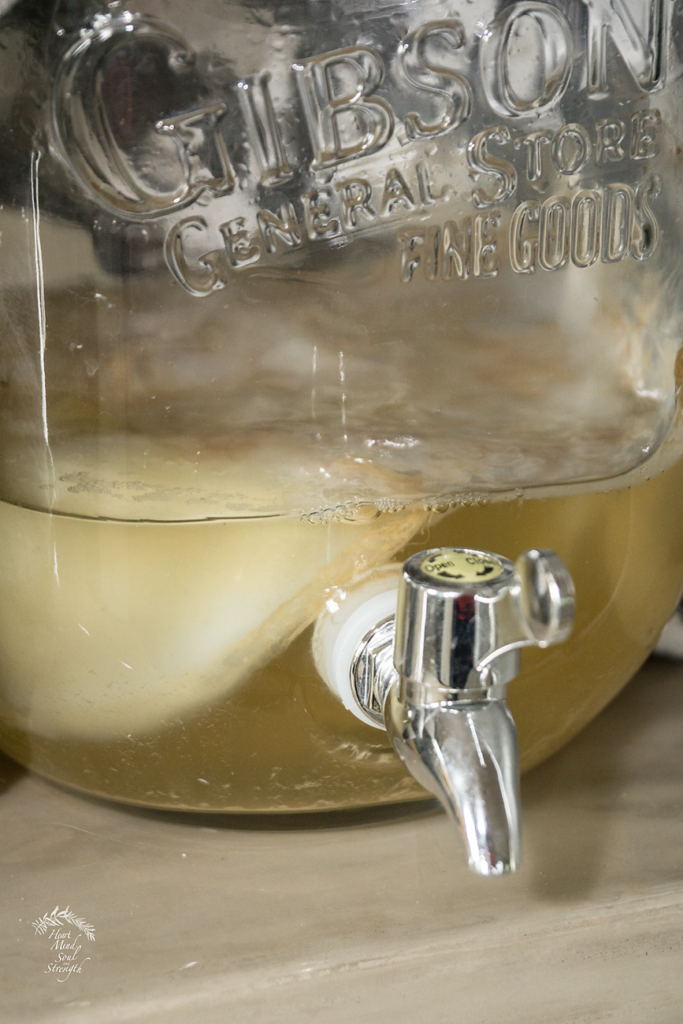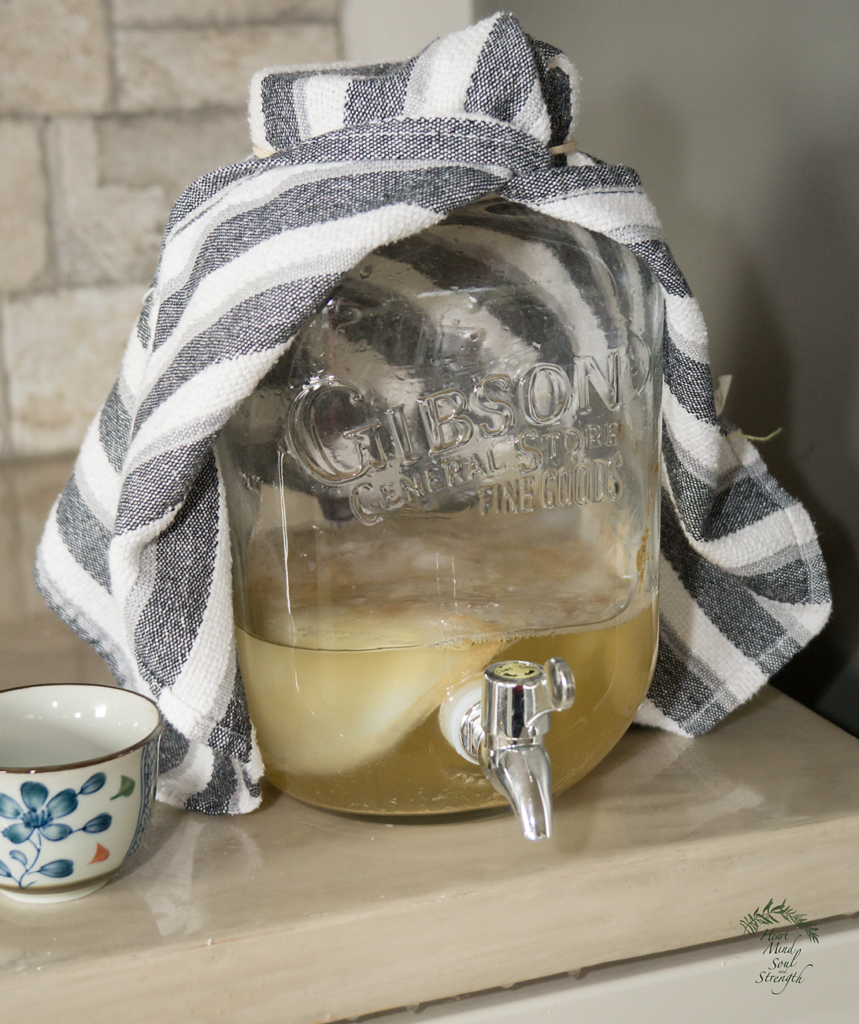You may not choose to brew your own kombucha, but maybe you’re a little curious. I’ve been brewing kombucha for a couple of years and enjoy having on hand a healthful drink to enjoy for pennies.
First of all, what is kombucha? Perhaps you’ve seen it in health food stores, Costco and other grocery stores, restaurants, even kombucha bars and wondered what all the hype is about. Kombucha is fermented tea. It isn’t alcoholic- at least not measurable amounts, instead, it’s fermented like vinegar with a mother called a SCOBY. Scoby is an acronym for Symbiotic Culture of Bacteria and Yeast. It is both bacteria and yeast, so the  scoby is a living organism having specific needs. It needs to be fed sugar and it needs a temperature range of 75-85 degrees in order to ferment the sweet tea. But don’t worry, the sugar you add is digested by the yeast, leaving only a few calories when you drink it. The health benefits have been hotly debated with claims ranging from probiotic digestive benefits to reducing inflammation. I feel it does help my finicky stomach and besides, I like the taste! Not too sweet and just a little tang like carbonation. It’s very low calorie and it definitely has probiotics and antioxidants, so it’s guilt free enjoyment.
scoby is a living organism having specific needs. It needs to be fed sugar and it needs a temperature range of 75-85 degrees in order to ferment the sweet tea. But don’t worry, the sugar you add is digested by the yeast, leaving only a few calories when you drink it. The health benefits have been hotly debated with claims ranging from probiotic digestive benefits to reducing inflammation. I feel it does help my finicky stomach and besides, I like the taste! Not too sweet and just a little tang like carbonation. It’s very low calorie and it definitely has probiotics and antioxidants, so it’s guilt free enjoyment.
Should you buy it or make it? If the commercially bottled kombucha you buy is pasteurized, the microbes are killed and cannot offer the health benefits of live cultures. If the commercial drink is sweetened, it is no longer the low-calorie drink made at home. If it is flavored with artificial flavors, it’s no longer the pure, chemical free beverage home brewers love. Just sayin’. Check the bottle.
Drinking too much, especially if you are new to kombucha can give you diarrhea, so ease into it slowly if it has live cultures. Most people work up to drinking about 8 oz daily. I drink about 4 oz. three or four times a day, but no more than 16 oz. daily. I’ve tried drinking it at different times, but what seems to work best for me is drinking a little with each meal. I tried drinking it before meals, but it is acidic and made my stomach sour. There is a lack of true scientific study on Kombucha, especially home brewed which varies with temperatures and brew times. So I don’t try to tell others what they should do. I only know what works for me.
Here is the simple method I use to brew.

Get a scoby from a trusted friend. (I bought my first scoby online and it didn’t work.) Get plenty of brewed kombucha with your new scoby, at least a cup and more is preferable for a fast start.
Put the scoby culture and the already brewed kombucha into a glass container with a spigot. I have used a 2.5 gallon “Beehive” beverage dispenser but found it to be too large. You see, the culture will cover the surface of the tea in whatever size container you have. A wide container will cause a large scoby to form. I felt mine was so large that it caused my brew to ferment too fast. This causes a sour brew. I have now moved my culture to a smaller glass 1-gallon beverage container with a spigot. This way I’m brewing smaller amounts and the brew is being drawn off quicker which doesn’t allow it to sit and ferment for too long becoming sour.
Every other day I add fresh sweet black tea to the container at night so it has 10 hours to brew before I draw any off the next day. Since the proportion of already brewed kombucha to fresh tea is about half and half, the fermentation occurs quickly. If I can’t add the fresh sweet tea at night, I do draw off enough to drink for the next 12 hours before adding fresh tea. If the taste becomes too sour (vinegary), I immediately draw off enough brew to leave only one quart remaining in the container. I then steep a fresh quart of sweetened tea and add it to the quart of brew. After 12 hours, I have a good balance and mild taste again.
 Here is how I brew the tea for Kombucha:
Here is how I brew the tea for Kombucha:
I don’t bring water all the way to the boil. It seems that the tea is milder if I don’t use boiling water. I bring it to only to 140-150 degrees which kills off most bacteria that might be on my teapot or the tea. You can boil your water if it makes you feel better.
I use about a tablespoon of loose oolong tea that was given to me by Chinese friends and brought directly from China. I also use green tea from time to time. Green tea alone doesn’t seem to produce a pleasing brew, however.
I slowly pour the hot water over the loose tea in a strainer in a teapot which has 1/4 cup of sugar already added.
I cover my teapot and set my timer for 3 minutes of steeping time and take the tea strainer out of the pot immediately upon reaching the 3-minute point. This prevents bitter tea. If you steep too long, your tea will be so bitter you won’t enjoy it. I reuse the loose tea one time, storing it in a glass container with a lid in the fridge until using it again two days hence.
I stir the sugar at the bottom of the teapot into the steeped tea with a clean butter knife.
I taste the tea to see if the temperature is cool enough to drink.
If it isn’t too hot to drink, I add it in a very slow stream to the brewing container with the scoby and the remaining already brewed kombucha. Pouring it slowly cools it and oxygenates it. The warm fresh tea raises the temperature of the brew slightly which makes it happy. It ferments a little quicker making a mild flavor.
I wait 12 hours while it ferments and then draw off some kombucha to drink.
The temperature of the room is important. Kombucha is happiest at 75-85 degrees. If your room drops below 70, you’ll want to use a heating pad made especially for the purpose.
Don’t put a lid on your brewing container! The living organism needs to breathe. Cover with a cloth secured with a rubber band. I use a dish towel which is long enough to cover the brewing container so sunlight doesn’t adversely affect the process.
I don’t bother the scoby. About every six months, I wash the container and separate the layers of the culture. I store some of the layers in a clean jar with the brew and cover with a cloth secured with a rubber band. I store in a cupboard ready to give away or as a back-up if needed.
The remaining layers of scoby are rinsed off and any pieces of tea leaves are picked off. Then the scoby is returned to the brewing container along with already brewed kombucha and I add some fresh sweet tea.
This site was helpful to me when I was learning. HERE